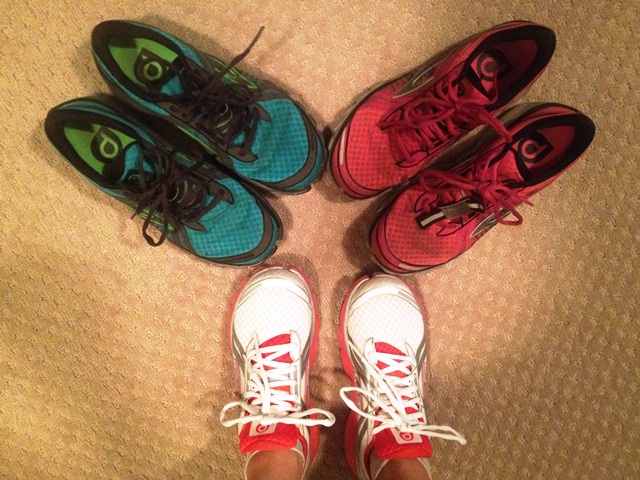Another Pair of Running Shoes: When to Buy & How to Make Them Last
Last week I found myself in one of my very favorite, yet most dangerous places. My local running store. I could literally buy everything in the joint if my wallet said I could. To say I’m obsessed with my running shoes would be an understatement. You can imagine my excitement when the mileage on my current shoes hit the number signaling it’s time to break in a new pair before the Marine Corp Marathon in 6 weeks.
I’ve been running in Brooks shoes for a long time. For the last year, I’ve been running in their Pure Cadence, which I L-O-V-E. I’ve been completely injury and pain free (*vigorously knocking on wood at this very minute*), and I believe I have these shoes to thank … of course along with a smart training plan.

Running in old shoes that have too many miles on them is one of the most common causes of running injuries. Continuing to run in worn-out running shoes that have lost their shock absorption, cushioning and stability increases the impact and stress on your body and can lead to issues such as shin splints, IT band pain, knee issues and much more (sadly, I know this from experience). One of the best things we can all do to help prevent injuries is to make sure we don’t keep running in shoes past their expiration date.
So how do we know when our shoes are worn out?
According to the experts at Runner’s World, you should get new shoes every 300 to 500 miles based on your running style, the surface you run on and your weight. They offer some great tips for what to look for when buying running shoes and how to avoid common mistakes. Whether you’re a new runner trying to figure out the shoe conundrum and pick the perfect kicks, or you’re training for a fall marathon or half-marathon and are deciding if it’s time for a new pair before race day, let’s break down the basics of getting the most shoe bang for the buck.
Tips for Knowing Your Running Shoe Lifecycle
- Celebrate the birth of your shoes and use a training log to track your mileage. When you get a new pair of shoes, record the date you purchased them, and use a training log to keep track of how many miles you’ve run in them. I use Daily Mile (you can find me on Daily Mile here). When you’ve hit about 400 miles, assess how you’re feeling. When my shoes are completely worn out, I begin to get light shin splints and know I’ve waited too long. The goal is to get your new pair before aches and pains start to set in. Runner’s World Coach Jenny Hadfield recommends writing the purchase date on the inside of each shoe’s tongue so you never forget when you first started running in them. Genius!
- Look at the tread on the bottom of your shoes. Once I’ve hit that 300 to 500 mileage range in my shoes, I typically look at the tread in the mid-sole area to see if it is worn down. Just as tires on your car start to bald when it’s time (or past time) for a new set, the same thing happens with our running shoes. If the tread is thin, that’s usually a good indication it is time for a trip to your local running store.
- Consider running in 2 pairs. Alternating between 2 pairs of shoes can help extend their lifecycle by allowing them to properly dry out and rest between runs. Some experts recommend buying and starting to run in your next pair of shoes halfway through the lifecycle of your current pair so you can compare and see the difference in tread to be more aware of when it’s time to say sayonara to the old and welcome in the new.
- Avoid the dryer. The heat of a dryer can speed up the break-down process of your shoes and limit the lifecycle of their cushioning and shock absorption abilities.
- Use running shoes just for running. The more you use your shoes, the quicker they are going to break down. If you walk everywhere you go in your running shoes along with all the miles you log training in them, they are likely going to need to be replaced more quickly.
And please, whatever you do, don’t go to a sports megastore to buy your shoes if you’re just getting into running or are trying to figure out which shoe is the best for your body. Go to a local running specialty store where the employees are runners themselves, are trained in how to fit shoes based on your running style and pronation level and understand what causes and prevents overuse injuries. The worst thing you can do is go to a big sports warehouse where the sales people (who are friendly but know nothing about running) gladly ring up for you the coolest looking neon pink shoes with hot yellow laces that don’t provide the stability or support you need. You might pay a little more up front at a specialty store, but in the end, staying healthy and injury-free is more than worth it.
What Should You Do with Your Old Shoes?
There are a variety of organizations that collect old running shoes for a good cause. Consider donating your tired shoes to one of these types of organizations rather than just tossing them. Below is a list of groups I’ve found online that will gladly accept your expired soles.
- www.soles4souls.org
- Hope Runs
- Shoe4Africa
- Nike Reuse-A-Shoe
- The Shoe Bank
- Samaritan’s Feet
- Shoes for Planet Earth
- Share Your Sole
- You can also check with your local running store to see if they accept your old shoes. Some may even give you a small discount for trading in your old shoes when you’re buying new ones.
What are your favorite shoes to run in? Have you ever suffered from an overuse injury because you ran in the same pair of shoes for too long?



Comments
I am a Brooks girl too – and I love them. I’m not sure if they are for a particular foot type, but the best fits so far have been the Glycerins and now the Ravennas. I’m still getting the hang of the shoe thing…when I started running (about 10 months ago) I was running in cross trainers. Oh dear
So excited for your new shoes! Does this mean a speedy marathon recap is on the horizon?
I think Brooks makes excellent shoes for people who need more stability, including over-pronators. I have run in the Ravennas before and they weren’t the right shoe for me. I’m glad you’ve found the shoe for you! I do hope my Pure Cadence will help propel me to a PR on October 28. Fingers crossed!
Good timing! My shoes are sending me signals. I run in Saucony Kinvara 3’s and I love them.
I think I’ve got some ligh pain going on and I know they’re worn out. I hear the $$$$$ ringing.
Brooks Adrenalines are my go-to shoes. I started running in them in late 2009, and can’t wait for the Adrenaline 13’s to come out in the Spring. I’m a shoe-rotator. My main pair just went over 300 miles yesterday, and my back-up pair (which will now be my MCM race-day shoes) has about 180. So I’ll be heading to the running store probably next week for a new set of kicks.
Great strategy, Dave! I used to run in the Adrenalines for about two years and really liked them. I did the 2010 Chicago Marathon and 2011 New Orleans Marathon in them. I think they may have provided just a touch too much stability for me, and I tended to experience IT band issues late in the season. I’ve found the Pure Cadence to provide the same, solid stability in a lighter and more cushioned shoe.
This was a great post, thanks so much for sharing. I just got a pair of Saucony Omni 11s and I LOVE them! I’m thankful the running store recommended them to me.
So glad you found it helpful Erin! I hope your new shoes propel you through a great race and a new PR
I was just wondering about this very topic last night as I slightly limped off the trail I always run. Thanks for the advice! I’m gearing up for my first 10k on Sunday, so I’m hoping these shoes will keep me going at least that long.
I’m glad it was helpful, Karissa. I’m so excited that you’re running your first 10K this weekend! Please let me know how it goes!!! Hit me up on Twitter or Facebook after the race. I’ll be cheering for your virtually. And good luck getting a new pair of shoes after the race!
I’ve been in Nikes for a long time BUT I’ve been alternating between two styles. I never thought that it could be detrimental but it does make sense to me. I’m buying new shoes this weekend (thank heavens!) and might consider two of the same kind.
As far as my old shoes, my husband is a middle school track coach (and teacher) at a school where most of the kids are on free and reduced lunch. Some of the kids start the season in loafers, very cheap shoes or Van-type sneakers. He just took two pairs of my old shoes for the girls team. Even if the fit isn’t great, the shoes are better than what they had.
I love that you and your husband give your used shoes to his students. That is really wonderful!